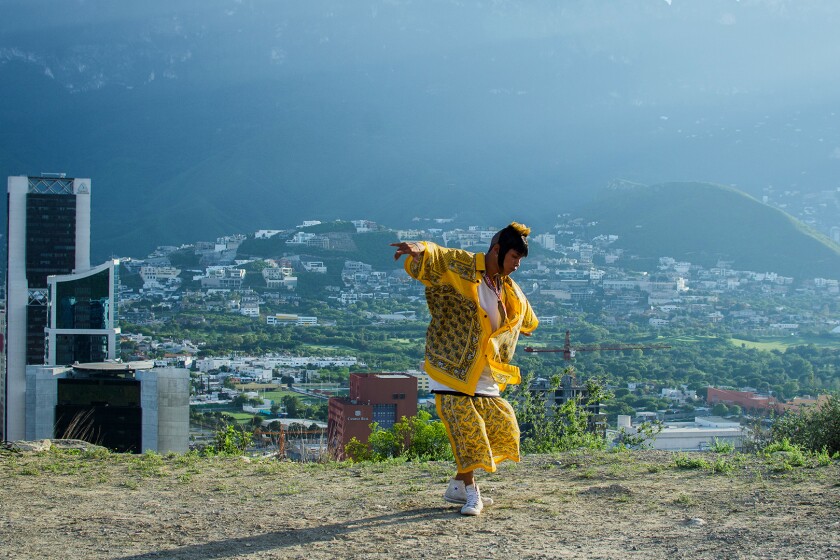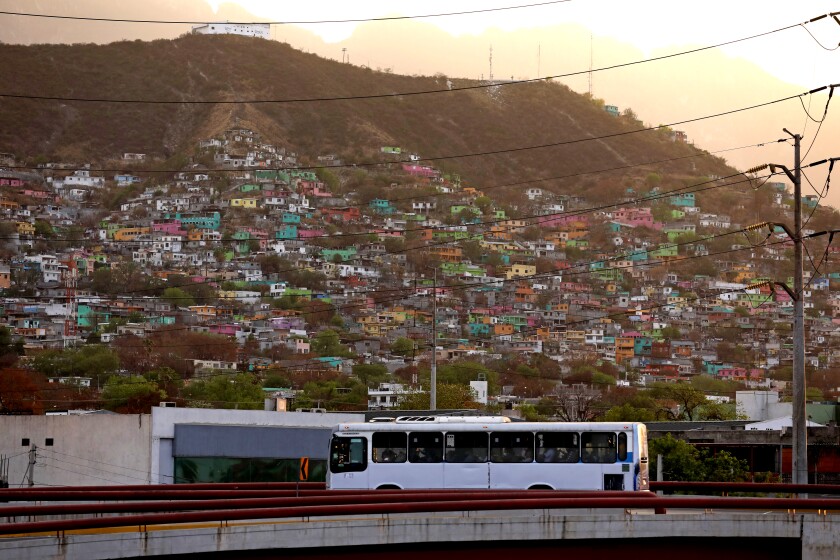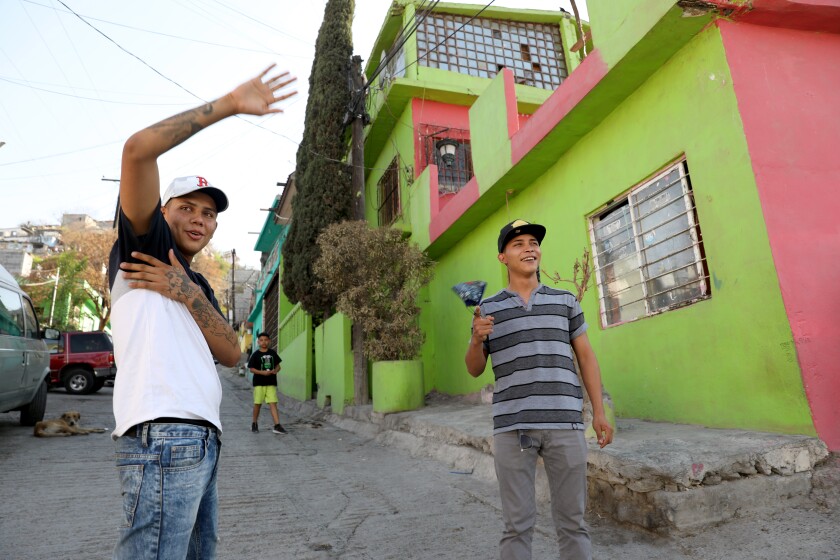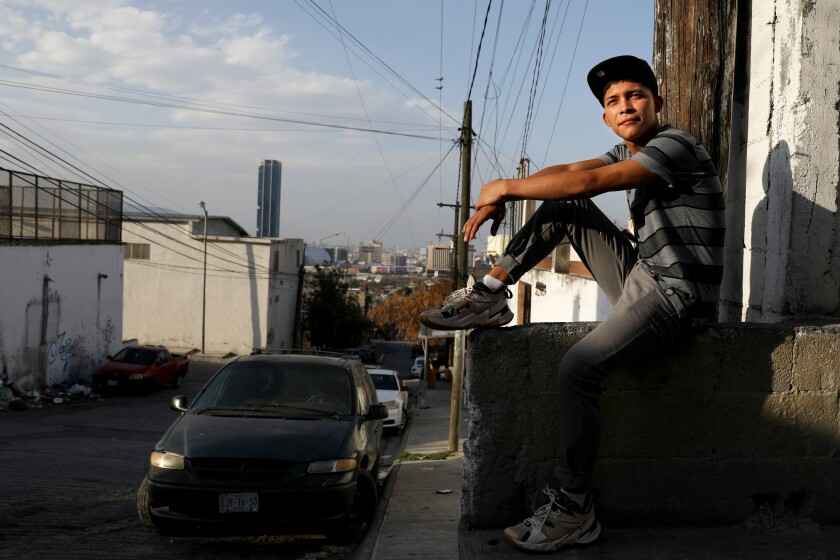A decade ago, violence exploded in Monterrey, a city of 5 million built around the craggy peaks of the Sierra Madre Oriental mountains. Armed gangs took over highways, strung bodies from bridges and burned down businesses whose owners refused to pay them “protection” money.
Many actors draw from personal experiences to build characters, but García, who grew up within the same conflictive era in which the film is set, was uniquely poised to do so.
And while he was too young to be part of the cholombiano dance scene that is featured in the movie — a Monterrey-specific counterculture in which teenagers donned baggy clothing, styled their hair in extravagant punk cuts and twirled to hypnotic cumbia songs slowed down in tempo — his two older brothers were a part of that world, and García also used cumbia music to escape the strife.

Juan Daniel García Treviño showing off dance moves in “I’m No Longer Here.”
(Netflix)
At a young age he began playing the güiro, the guacharaca and other percussive instruments in a family band. He’d work as a welder during the day and perform on buses and at neighborhood parties at night.
García, who had tried from an early age to be a peacekeeper, somebody who would help rivals settle disputes with words instead of violence, liked being a part of events that brought his community together even as it was divided by gang warfare.
It was during his band’s biggest gig ever — opening for late cumbia legend Celso Piña in 2016 — that a casting crew spotted him and invited him to an audition.
Soon he and a group of other charismatic kids from the streets were taking part in an acting intensive that director Fernando Frías de la Parra likened to summer camp.
The teenagers who would go on to play a dance crew known as Los Terkos (the stubborn ones) spent three months living together and working with Frías de la Parra and acting coach Bernardo Velasco, one of the stars of HBO’s cult Spanish-language comedy series, “Los Espookys,” whose first season Frías de la Parra directed.
Frías de la Parra cast García as Ulises, the leader of Los Terkos, because like his character he was even-keeled and seemed wiser than his years. There was also his magnificent voice — low and rhythmic, not unlike the instruments he played.
But still, García and the other non-actors had a lot to learn.
They were taught to connect with their bodies through daily sun salutations and with their emotions by examining their own past. “What was your toughest experience on the street?” Frías de la Parra might ask.
For García, it was a kind of therapy. He began to realize the terror he lived with as a kid, when he feared that every knock at the door might be one of his father’s rival gang members, there to kill the whole family.
“I hated being there and unable to leave,” García said. “I wanted to go anywhere else.”
The film is a clear indictment of the U.S.-backed drug war in Mexico, which did not reduce drug trafficking and sparked years of record levels of homicides.

Fernando Frías de la Parra, the director of “I’m No Longer Here” on Netflix.
(Ana Hop / Netflix)
But Frías de la Parra, a Mexico City native who wrote first drafts of the film while he was a student at Columbia University, wanted to show more than just how that strategy had failed.
He was tired of the representations of violence that had come to define much of Mexican cinema — in large part because of the expectations of American audiences.
“It seems like the niche or the space for a film that comes from this region ... can only be about the tragedy of being coming from these places,” he says over Zoom. “It’s really sad to see directors trying to replicate or emulate these violent portrayals of their country not because of a truthful connection with the subject matter, but because of it being a shortcut to making it outside of Mexico.”
And so while the film revolves around a horrific act of violence — a drive-by shooting that forces Ulises to flee Mexico — the movie is less about that than the culture and community forged by young people in the midst of that strife.
“The idea was to have a film that is more open and has more air so that you can, as an audience, maybe see that yes, violence is part of that environment,” says Frías de la Parra, “but so is joy and growth and other things.”
It took years to make the movie, in part because the U.S. embassy in Mexico rejected García’s visa application to travel to New York three times.

La Independencia, seen here on March 23, 2021, is a working-class neighborhood where the movie “I’m No Longer Here” was filmed. Built on a hillside, the neighborhood is across the river from the downtown district of Monterrey, Nuevo Leon.
(Gary Coronado / Los Angeles Times)
There were other challenges: At age 4, both of García’s legs were broken when an uncle accidentally ran him over while leaving a party. The film’s many dance scenes, which required García to crouch low to the ground and slowly spin, were painful.
But García loved the whole process, in part because it showed him there is a big world outside of the barrio.
Sometimes he feels survivor’s guilt: “A lot of guys where I’m from can’t even think about that, about getting out.”
When the film premiered last spring, he became an overnight sensation, drawing comparisons to Yalitza Aparicio, a non-actor from Oaxaca who starred in the Alfonso Cuarón-directed “Roma” and was nominated for a lead actress Oscar.
Unlike Aparicio, who went three years before acting in another feature film, García has already shot roles in two movies, “La Civil” by Bulgarian director Teodora Mihai and an as-yet untitled film by Natalia Lopez. Acclaimed director Amat Escalante also cast him in an episode of “Narcos.”
His roles in each of the films were similar: Young men on the margins of society.
Some older actors have warned him about the dangers of getting typecast.
García says that one day he would like to branch out to different kinds of parts — and maybe even direct. But for now he’s comfortable playing characters he knows.
“I’ve tried not to overthink why are they pigeonholing me like this,” he says. “The roles I play, this is what I am too. I can create these characters. I can interpret them well. It’s thugs. It’s people from the barrio. I’m barrio.”
And yet the success of “I’m No Longer Here” has pulled him away from the barrio and into a very different world.
It feels too risky now to hang out with friends back in his neighborhood. “If I’m going to be there, smoking on the corner, the police might give me trouble,” he says, “and that’s not cool.”
And yet he is still very much at home on the streets.

MONTERREY, NUEVO LEON - MARCH 22: Actor Juan Daniel García Treviño, 21, right, protagonist of the movie Ya no estoy aqui (I’m No Longer Here), talks with Rodrigo Maldonado, 16, left, a local resident of La Independencia, a low income working class neighborhood, where a shooting scene was filmed in the movie, on Monday, March 22, 2021 in Monterrey, Nuevo Leon. Daniel won the 2020 Ariel Award, organized by the Mexican Academy of Film Arts and Sciences (AMACC), for Best Breakthrough Artist. The movie was released via Netflix on 27 May 2020. (Gary Coronado / Los Angeles Times)
(Gary Coronado/Los Angeles Times)
On a recent afternoon he is trudging up a steep hill in a hard-scrabble neighborhood known as Alianza, where much of the film was shot. He is with a photographer, who wants to take his picture in some of the movie’s locations near the top of a hillside, with sweeping views of the valley below.
But getting there is tricky. “There’s a different gang on every corner,” he says.
He approaches a group of men gathered drinking beer, diplomatically asking to enter their section of the neighborhood. “With your permission,” he says. They exchange fist bumps and they let him pass.
In front of a watermelon-colored house where they filmed the shootout scene, he stops and says hello to the owner and her son, a teenager with a tear drop tattooed above his left eye. He tells them about the real-life shooting that took place in the same location several years before the movie was filmed. “They killed my cousin,” the young man says.
He and the photographer walk farther up, past kids playing in the street and a group of people drinking and listening to cumbia music. At the top of one narrow staircase, two older women urged them to turn back.

MONTERREY, NUEVO LEON - MARCH 22: Actor Juan Daniel Garcia Trevino, 21, protagonist of the movie Ya no estoy aqui (I’m No Longer Here), poses for a portrait in La Independencia, a low income working class neighborhood, where the movie was filmed, on Monday, March 22, 2021 in Monterrey, Nuevo Leon. Daniel won the 2020 Ariel Award, organized by the Mexican Academy of Film Arts and Sciences (AMACC), for Best Breakthrough Artist. The movie was released via Netflix on 27 May 2020. (Gary Coronado / Los Angeles Times)
(Gary Coronado/Los Angeles Times)
“It’s been bad lately,” one of the women says of robberies by local gangsters. “This is the hour when they’re out.”
It’s nearly dusk anyway, so they decide to head down. Near the bottom they pass two teenagers, a brother and sister.
“That’s the guy from the movie,” the young man whispers loudly.
“How do you know?” she asks.
He’s wearing a surgical mask, and the haircut he sported in the film, an elaborate look with extended sideburns, is long gone, replaced by a short cut with straight fringe bangs across his forehead.
“I can tell by his voice,” the brother says.
They get up the courage to ask García for a photograph.
“It’s so great that you’re here again,” the sister says as they pose. “Thanks for remembering the hood.”
"movie" - Google News
May 11, 2021 at 12:07AM
https://ift.tt/3xYJ8yX
His first movie was shortlisted for an Oscar. What's next? - Los Angeles Times
"movie" - Google News
https://ift.tt/35pMQUg
https://ift.tt/3fb7bBl
Bagikan Berita Ini














0 Response to "His first movie was shortlisted for an Oscar. What's next? - Los Angeles Times"
Post a Comment